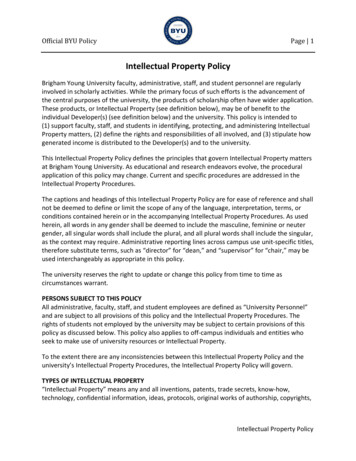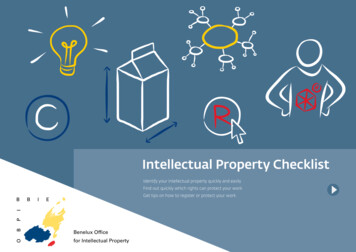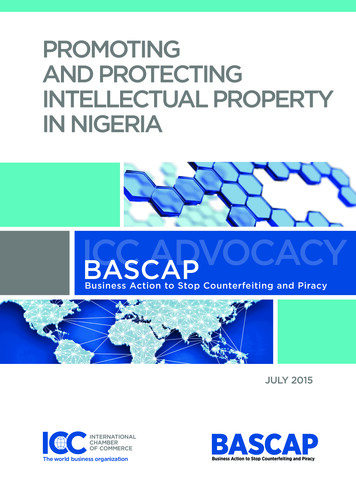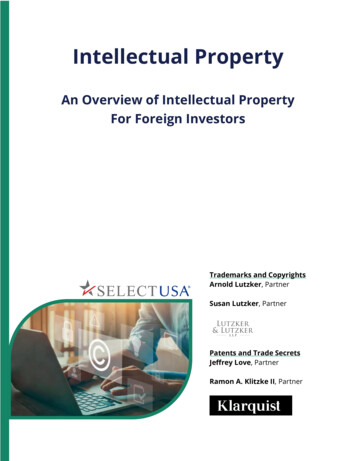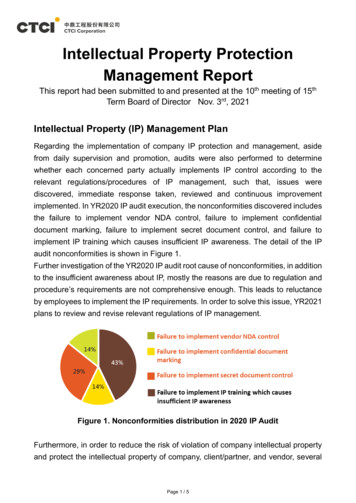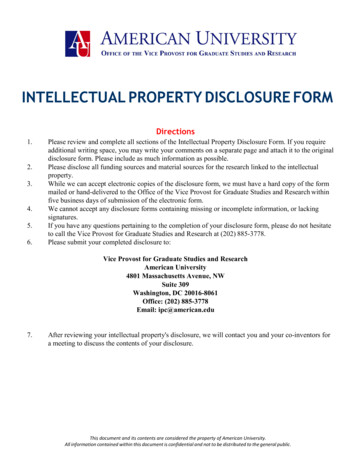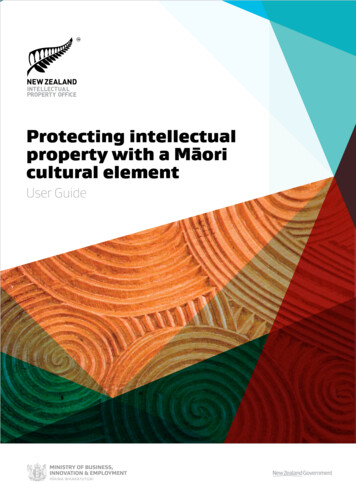
Transcription
Protecting intellectualproperty with a Māoricultural elementUser Guide
MB13524 JUNE 2016Disclaimer: The information provided in this intellectual property guide is intended to provide generalinformation to the public and every effort has been taken to ensure that the information contained in itis accurate. However users of the guide are advised that the information provided does not replace oralter the laws of Aotearoa-New Zealand and any statements made or views expressed in this guide donot necessarily reflect Aotearoa-New Zealand government policy. Readers should seek specific advicefrom a professional qualified in the relevant subject area before undertaking any action following theinformation received in this guide.ISBN (online) 978 0 947497 96 5Cover image: Spiral carving, New Zealand, credit: One Shot/PNZ/Stephen RokeContentsIntroduction 2Copyright and mātauranga Māori31Māori Advisory CommitteesGeographical indicationsand mātauranga Māori35Trade Secrets andmātauranga Māori37Cultural considerationsin relation to mātauranga Māori69Trade marks andmātauranga Māori 17Patents and mātauranga Māori23Design registration andmātauranga Māori 26Plant variety rights andmātauranga Māori29Enforcement of intellectualproperty rights 38Tips for an effectiveintellectual property strategy41
ForewordIntellectual property rights can be key economic assets for businesses. Used strategically, theycan play a leading role in realising the full financial potential of New Zealand’s creative and innovativeindustries.He Kai Kei Aku Ringa, the Crown-Māori Economic Growth Partnership, sets out the government’sstrategy and action plan for economic development in the Māori business sector. As the governmentagency responsible for the granting and registration of intellectual property rights, the IntellectualProperty Office of New Zealand (IPONZ) recognises the unique social and cultural significance ofMāori knowledge, innovations and cultural practices. IPONZ contributes to He Kai Kei Aku Ringa byassisting Māori businesses, communities and organisations to identify, manage and protect theirintellectual property.New Zealand is internationally recognised as a leader in the area of indigenous intellectual property.The First International Conference on the Cultural and Intellectual Property Rights of IndigenousPeoples was hosted in New Zealand in 1993, and nations continue to look to us for guidanceas we work to protect Māori cultural heritage. Our trade mark and patent laws are recognisedinternationally for providing for the establishment of Māori Advisory Committees to advise theCommissioner on whether proposed intellectual property would be offensive to Māori, or contraryto Māori values, if approved.This guide is designed to assist Māori individuals, communities, organisations and enterprises togain an understanding of intellectual property rights in order to manage effectively the creativityand innovation taking place in the Māori economic sector.This guide is also designed for others, both in New Zealand and internationally ‒ who wish toregister intellectual property with a Māori element, but who may lack knowledge of the cultural,spiritual and economic values associated with mātauranga Māori (Māori knowledge), and of thegovernment policies in place to protect it.Mandy McDonaldCommissioner of Patents, Trade Marks, Designs and Plant Variety RightsKaren Te O Kahurangi WaakaChair, Trade Marks Māori Advisory CommitteePare KeihaChair, Patents Māori Advisory Committee1
IntroductionOverviewThis publication gives guidance on the special considerations in New Zealand around the use andregistration of intellectual property that contains an element of Māori culture, for example, a Māoriword, image, or design.It will assist Māori communities and businesses to understand how intellectual property rights workas commercial assets, and give them guidance on how they can use unique aspects of Māori cultureappropriately to create business opportunities, attract investment, and increase profits.It also explains the purpose and role of these special considerations in the protection of mātaurangaMāori ‒ the values, concepts, meanings and traditional knowledge of Māori culture ‒ and showspeople from diverse cultural backgrounds how they can use Māori cultural elements in theirintellectual property without causing offence.Intellectual Property Office of New ZealandThe Intellectual Property Office of New Zealand (IPONZ) is the government agency that manages thegranting and registration of intellectual property rights in New Zealand. IPONZ is a business unit ofthe Ministry of Business, Innovation and Employment (MBIE).The IPONZ website offers extensive information on intellectual property, designed for a wide rangeof users, from those with little knowledge of intellectual property, to businesses already managingmultiple intellectual property rights, and intellectual property professionals such as businessadvisors or patent attorneys.IPONZ has made its services easy to use, and is the first intellectual property office in the world todo all of its business online, including receiving and processing applications for intellectual propertyrights. Once applications are received, they are assigned to an IPONZ staff member who is availableto answer any questions not covered by the general information available.This document will at times suggest that the reader go to the IPONZ website for more informationon a particular topic. The IPONZ website address is www.iponz.govt.nz.The CommissionerNew Zealand Patents, Trade Marks, Designs and Plant Variety Rights laws require the government toappoint a Commissioner to carry out specific roles in relation to these intellectual property rights. Allfinal decisions about whether applications for intellectual property rights are approved are made bythe Commissioner. The communications that tell applicants whether their intellectual property righthas been granted or approved will come from the Commissioner.2
Intellectual property and mātauranga MāoriMātauranga Māori is a unique New Zealand taonga (treasure), central to our national identity. Mostcommonly translated as Māori knowledge, mātauranga Māori is a broad term referring to the body oftraditional knowledge that was first brought to Aotearoa–New Zealand by Māori ancestors. It is a livingbody of knowledge passed from generation to generation, and so it may also refer to modern-dayMāori values, perspectives, and creative and cultural practices, including te reo ‒ the Māori language.There are some aspects of mātauranga Māori, such as traditional knowledge, that are difficult toprotect using registered intellectual property rights. For example, to be registered or granted, adesign or a patent must be new and original, but inventions derived from traditional knowledgemay have developed over centuries. Also, most intellectual property rights are owned by individualsor a commercial business, while traditional knowledge belongs to a collective group.Despite these issues, it is possible to identify elements of Māori culture that present uniquebranding opportunities and potential commercial benefits that can be protected through intellectualproperty rights. These intellectual property rights can help Māori individuals, organisations andbusinesses control the commercial use of their cultural expressions and traditional knowledge,to ensure that mātauranga Māori is recognised and respected.It is also important that people with diverse cultural backgrounds understand how they can borrowand use aspects of Māori culture in their intellectual property in appropriate and respectful ways.New Zealand’s patent and trade mark laws require the government to set up special processes forthe protection of mātauranga Māori in the granting of intellectual property rights. These processes,discussed in detail in the next chapter, empower the Commissioner to prevent the registration oftrade marks and designs, and the granting of patents, that would be considered offensive to Māori,or contrary to Māori values.Māori cultural elements in intellectual propertyA Māori cultural element is some aspect of the intellectual property that reflects, or is taken from,mātauranga Māori. A Māori cultural element could include:›› a Māori word or design›› indigenous (native to New Zealand) plants or birds›› Māori music or danceThe Māori cultural element may be a small part of the intellectual property (such as the use of a Māoridesign or word on a product not specifically related to Māori culture), or it may involve the entireintellectual property (such as recording or performing a Māori song or dance).Types of intellectual propertyThere are seven types of intellectual property discussed in relation to mātauranga Māori in thisguide: trade marks, patents, designs, copyright, plant variety rights, geographical indications,and trade secrets.IPONZ manages the registration of trade marks, patents, designs, and plant variety rights.The registration of geographical indications by IPONZ is scheduled to begin in 2016. Copyrightand trade secrets do not need to be registered, as they belong automatically to the owner of thecreation (for example, the author of a book, or the owner of a particular drink with a unique flavour).Applications for Trade marks and patents have a special advisory process for the considerationof Māori cultural elements by a Māori Advisory Committee, discussed in the next section. Designapplications may also go through the advisory process set out for trade marks.Plant variety rights do not have a separate process for considering Māori cultural elements.The table on the next page shows the main types of intellectual property rights, what they protect(with examples), and their duration.3
Types ofintellectualpropertyWhat it protectsDurationTrade MarksUnique symbols, words, or names that are part10 years(renewableindefinitely)of a brand or logo a business uses to identify itsgoods and services in the marketplace.Examples: logos used on goods and servicesRegistered by IPONZMay be referred toa Māori AdvisoryCommittee forconsideration of Māoricultural elements.PatentsNew and non-obvious inventions, products,Up to 20 yearsand processes.Examples: manufacturing processes, chemicalcompounds, pharmaceuticals, textiles, and foodprocessing equipmentDesignsDesigns, including shapes, configurations, patternsor ornaments that are applied to an article by anindustrial process.Up to 15 yearsExamples: fabric, bottles, crockery, clothingGeographicalIndications whenin forcePlace names used on wines and spirits from aspecific location with particular qualities that areattributable to that place of origin.Not yetdeterminedExample: the term 'champagne' can only be usedin relation to wine produced in the Champagneregion of FranceRegistered by IPONZNo separateconsideration processfor Māori culturalelements.Plant Variety RightsExclusive rights to produce a new plant variety20-23 yearsfor sale and to sell its propagating material.Example: new varieties of applesCopyrightExclusive right to use and distribute original literary,artistic and musical works; performances, soundrecordings, film, software and broadcasts.Life of the authorplus 50 yearsAlso moral rights for authors and directors inrelation to their works and performers’ rights overlive communication of their performances to thepublic and recording of their performances.Do not need tobe registeredThey exist automatically.Examples: Waiata, kapa haka performances, koauautunes, weaving, carvings, jewellery, booksTrade SecretsConfidential business information about thecomposition or manufacture of a product that givesa company a competitive advantage.Example: recipes44Not applicable
THE INTELLECTUAL PROPERTY OFFICE OF NEW ZEALANDGUIDE TO PROTECTING INTELLECTUAL PROPERTYWITH A MĀORI CULTURAL ELEMENTWaitangi Tribunal reportKo Aotearoa Tenei(Wai 262)In July 2011, the Waitangi Tribunal issued a report entitled Ko Aotearoa Tenei,commonly referred to as the WAI 262 report. Since its release, the WAI 262report has been under consideration by the Crown. The claims and report raisea wide ranging number of matters with implications for many different areas,including intellectual property.Here are four examples of actions taken by the government in relationto intellectual property as a result of the WAI 262 claims:02132020New Zealand’s trade mark registration rules werechanged in 2002 to empower the Commissionerof Trade Marks to refuse to register a trade markif its registration or use would be likely to offenda significant section of the community, includingMāori. A Māori Advisory Committee wasestablished to advise the Commissioner of TradeMarks on whether the registration or proposeduse of a trade mark would be likely to be offensiveto Māori. (Note that this was in response to claimsthat had been made public prior to the issuanceof the report.)14201520The Haka Ka Mate Attribution Act 2014 waspassed, which provides a right of attribution toNgāti Toa in respect of the haka ‛Ka Mate’. Anyperson who publishes, broadcasts or shows a filmin public featuring ‛Ka Mate’ must attribute it toTe Rauparaha and Ngāti Toa Rangatira. ‛Ka Mate’is an example of a taonga work.The Geographical Indications (Wine and Spirits)Registration Amendment Bill was introduced toParliament in November 2015. The Bill empowersthe Registrar of Geographical Indications to refuseto register a geographical indication if itsregistration or use would be likely to offend asignificant section of the community, includingMāori. This effectively aligns the government’sapproach on geographical indications with theapproach it has already taken on trade marksand patents.A Māori Advisory Committee for patents wasset up by the Commissioner of Patents underthe Patents Act 2013 to advise the Commissioneron whether an invention claimed in a patentapplication is derived from Māori traditionalknowledge or from indigenous plants or animals,and if so, whether commercial exploitation of thatinvention is likely to be contrary to Māori values.5
Māori AdvisoryCommitteesNew Zealand trade mark and patent law requires the government to set up a Māori AdvisoryCommittee to provide advice on the registration of trade marks and granting of patents that havea Māori cultural element. There are two advisory committees:›› Trade Marks Māori Advisory Committee›› Patents Māori Advisory CommitteeDesign applications with a Māori cultural element may also be considered by the Trade Marks MāoriAdvisory Committee.Māori Advisory Committee members have a deep understanding of mātauranga Māori, and tikangaMāori (Māori cultural protocol). They play an important role in ensuring that the government doesnot register trade marks, patents or designs that are offensive to Māori or contrary to Māori values.Examples of the type of questions considered by the committees include:›› whether an image in a trade mark draws from Māori culture in a manner that could be offensiveto Māori›› whether an invention claimed in a patent application is derived from Māori traditional knowledgeor from indigenous plants or animals›› whether commercial exploitation of an invention (producing, marketing and selling it) would becontrary to Māori valuesDecisions on whether a trade mark or patent can be registered are made by the Commissionerof Trade Marks and Patents. The Commissioner considers the advice received from the MāoriAdvisory Committees in relation to an application, but is not required to agree with that advice.The Commissioner will consider the Committee’s advice alongside other relevant factors thatdetermine whether the trade mark, patent or design can be registered or granted. The advice ofthe Committee is shared with the applicant when the Commissioner tells the applicant whetherthe application has been approved.There is no extra cost when an application for a trade mark, design or patent goes to an advisorycommittee.Further information about the Māori Advisory Committees, their members and the Memorandumof Understanding and Terms of Reference for each is available on the IPONZ website.6
New Zealand law setting up the Māori Advisory CommitteesThere are sections of the intellectual property laws (Acts) which currently provide for the MāoriAdvisory Committees:TRADE MARKS ACT 2002Section 17(1)(c) of the Trade Marks Act says that the Commissioner must not register a trade mark“the use or registration of which would, in the opinion of the Commissioner, be likely to offenda significant section of the community, including Māori.”Sections 177-178 require the Commissioner to establish a Māori Advisory Committee “to advise theCommissioner whether the proposed use or registration of a trade mark that is, or appears to be,derivative of a Māori sign, including text and imagery, is, or is likely to be, offensive to Māori.”PATENTS ACT 2013Section 15 of the Patents Act 2013 says that an invention that is “contrary to public order or morality”cannot be patented, and states that the Commissioner can “seek advice from the Māori AdvisoryCommittee” in making this determination.Sections 225-228 require the Commissioner to appoint a Māori Advisory Committee whose members“have knowledge of mātauranga Māori (Māori traditional knowledge) and tikanga Māori (Māoriprotocol).” The Committee is to advise the Commissioner on whether “an invention claimed ina patent application is derived from Māori traditional knowledge or from indigenous plants oranimals,” and, if so, “whether the commercial exploitation of that invention is likely to be contraryto Māori values.”DESIGNS ACT 1953The Designs Act 1953 does not provide for a Designs Māori Advisory Committee, nor does it makemention of Māori directly. It contains a more general provision that prevents the Commissioner fromregistering a “design the use of which would, in his opinion, be contrary to law or morality.” The TradeMarks Māori Advisory Committee may be asked to consider design applications with a Māori culturalelement under this provision.The advisory committee processWhen an application for a trade mark, patent, or design with a Māori cultural element is received byIPONZ, they decide whether the application needs to be considered by a Māori Advisory Committee.Some Māori cultural elements in trade marks and designs do not need Committee consideration(this is discussed in detail in the chapter Trade marks and mātauranga Māori).All applications with a Māori cultural element received by IPONZ go through the same considerationprocess, regardless of the cultural background of the applicant.If IPONZ decides the application needs to go to an advisory committee, the following will happen:›› IPONZ will let the applicant know that the application has been forwarded to a Māori AdvisoryCommittee.›› The Māori Advisory Comittee will consider the application in relation to mātauranga Māori at thesame time that IPONZ is considering other issues that may determine whether the intellecutalproperty can be registered or granted.›› The advice of the Māori Advisory Committee will be sent to the Commissioner via IPONZ, who willshare the advice with the applicant when the decision on the application is issued.If the Commissioner decides that an application must be declined based on advice from a MāoriAdvisory Committee, the applicant will be given the opportunity to respond. The Committee willbe asked to reconsider the application in light of any additional information from the applicantand give its advice to the Commissioner again.7
When an application is approved, the advice of the Committee may be shared with the applicant.Its advice may provide useful insights on how a product or service might be perceived by potentialconsumers, or it may raise other concerns that could influence whether the intellectual propertyis commercially successful.The advisory committee process is shown in the following diagram in the context of the generalapplication process. General application process flow charts for trade marks, designs and patentsare available on the IPONZ website.MĀORI ADVISORY COMMITTEE PROCESSMĀORI ADVISORYCOMMITTEEIPONZIPONZ receives an applicationfor a trade mark, patent,or design.APPLICANTIPONZ sees that the application contains a Māori cultural element that needs to go to aMāori Advisory Committee for advice. IPONZ forwards the application to the committeeand tells the applicant they have done so and why. (Some Māori cultural elements in trademarks and designs do not need Committee consideration. See the chapter on Trade marksand matauranga Māori.)The Māori Advisory Committeereceives the application andconsiders whether it would beoffensive to Māori, or contraryto Māori values, if registered.The normal IPONZ processhappens at the same timeas the consideration of theapplication by the MāoriAdvisory Committee.The applicant is told thattheir application has gone toa Māori Advisory Committee.The Māori Advisory Committeereaches a consensus, andsends its advice to theCommissioner (at IPONZ).The Commissioner receivesthe advice from the MāoriAdvisory Committee andconsiders it along with othergeneral application criteria.The Commissioner is notbound by the advice of theCommittee. The Commissionerreaches a decision on theapplication.The applicant is told of theoutcome of their application,including the Māori AdvisoryCommittee advice. If theCommissioner has rejectedthe application on the groundsit may be offensive to Māorior contrary to Māori values,the applicant may respond,giving reasons why theydisagree with the finding.The applicant’s response willbe sent to the Committee,who will decide if the responseovercomes their concerns.IPONZ follows steps fordeclined applications.or8IPONZ follows steps for approvaland registration of the new trademark, design or patent.
Cultural considerationsin relation tomātauranga MāoriMany people who apply to protect intellectual property with a Māori cultural element are familiarwith Māori culture and may have chosen their intellectual property for its specific Māori meaning.However, a growing number of products are referencing traditional Māori art and design, bothin New Zealand and overseas. Many of these items are mass-produced in factories outsideNew Zealand, often by non-Māori artists, and few of them have an understanding of Māoriculture to support them.The general information in this section about Māori culture and protocols can help anyone owningor planning to develop intellectual property with a Māori cultural element understand the culturalreasons behind some of New Zealand’s intellectual property laws and application processes.The information could save intellectual property owners time and money in developing intellectualproperty that may not be able to be registered.Recognising a Māori cultural elementIt may not always be obvious, even to the owner, that their intellectual property has a Māori element.Consider the following example:An applicant wants to register the trade mark ‛Tane’ for a new garden design consultancy. ‛Tane’means seed in Japanese. The applicant may not realise that ‛Tane’ also refers to Tānemahuta, theMāori god of the forest. ’Tāne’ is sacred to Māori, and the name could be offensive to Māori as atrade mark in New Zealand. The application would need to go to the Māori Advisory Committee forconsideration.The same principle may apply to Māori imagery. For example, a spiral–whether it is a koru or a Greekspiral design–is recognised as a Māori sign in New Zealand, and will be treated that way when a trademark or design application is assessed.For most Māori cultural elements, there is not a single set of explicit rules, or a one-size-fits-allprocess to follow.Cultural significanceCertain Māori words, expressions, performances, images, places, and things have special social,cultural and spiritual significance or meaning for Māori. There are many cases where it would notbe appropriate to copy or use a Māori cultural element, especially a traditional one.9
Even commonplace Māori words and designs should be treated with care because of their culturalsignificance. They may be familiar to the public, but significant to Māori, and therefore deservespecial consideration and respect. Failure to show appropriate respect may offend the public, andcan impact on the sales and success of a product. Consider the hei tiki:CULTURALLY SIGNIFICANT IMAGE:NEW ZEALAND HEI TIKIThe hei tiki is one of New Zealand’s most familiar,popular and recognisable Māori symbols. Thehei tiki is a small, carved ornament, usually ofgreenstone, worn suspended from the neck.Hei tiki is culturally significant, as it representsthe unborn child and is associated withHineteiwaiwa, the Māori goddess of childbirth.Using hei tiki for particular products or servicesmay be offensive to Māori. This can be raisedas an objection against an application for aNew Zealand trade mark or design, and mayimpact market sales.(Note that today hei tiki are often referred tosimply as tiki, but this shorter word traditionallyreferred to the much larger human figurescarved in wood guarding the entrance to a Māoripa (fortified village) and also the smaller woodencarvings used to mark a tapu (sacred) place.)There are two objects with Māori cultural significance that are protected by law in New Zealand:›› Ngāi Tahu’s relationship with pounamu (greenstone) is protected in the Ngāi Tahu (PounamuVesting) Act 1997 and the 2002 Pounamu Resource Management Plan›› the significance of the haka ‛Ka Mate’ as a taonga of Ngāti Toa Rangatira is acknowledged in theHaka Ka Mate Attribution Act 2014.Intellectual property owners, no matter how familiar they are with Māori culture, may benefit fromtaking time to learn more about the cultural significance of the specific Māori cultural element intheir intellectual property, and how it fits into their business plans. This might include contacting theappropriate Māori elders or iwi1 representatives to discuss how they plan to use or apply the Māoricultural element. It might also be helpful to talk through the circumstances in which the product wasdeveloped and the business plan.Applicants might also ask permission to use a particular Māori element, though in some cases itmay be difficult to establish ownership and identify who has the authority to grant permission.The process of seeking permission could also work against the need to keep some intellectualproperty, such as a design or an invention, confidential until it has been protected.TYPICAL MAORI DESIGN SHAPES1 An iwi is an extended kinship group of Māori, often associated with a distinct territory. An iwi may be composed of severalhapū, a family sub-group of an iwi.Note: These graphics are supplied with and without the accompan10
The concepts of tapu and noaTapu is the strongest force in Māori life. It has numerous meanings and references. Tapu canbe interpreted as ‛sacred’, or defined as ‛spiritual restriction,’ and can contain strong rules andprohibitions. A person, object or place which is tapu may not be touched or, in some cases, not evenapproached.Noa is the opposite of tapu and includes the concept of being common. Noa also has the conceptof a blessing as if it can lift the rules and restrictions of tapu from a person or object.To associate something that is extremely tapu, with something that is noa, is offensive to Māori.In the application to register the name ‛Tane’ for a new garden design consultancy, the applicantmight be able to explain that the use of the word ‛Tane’ (meaning ‛seed’ in Japanese) is as a referenceto man or men, and demonstrate that the designs or icons associated with the consultancy areconsistent with that meaning. In this case, it would not necessarily be regarded as offensivebecause it does not involve anything noa. If, on the other hand, the word was to be associatedwith a seed cake or biscuit, then the application might be regarded as offensive because of theassociation of something tapu with something noa.The association of tapu and noa in trade marks can be illustrated further:TAPU AND NOA: PAPATŪĀNUKU CHEESEPapatūānuku is one of the most significantMāori atua or tipuna (god or spiritual ancestor)and therefore tapu.A trade mark containing Papatūānuku ongoods (food) that are noa would be consideredoffensive, and could be raised as an objectionagainst a New Zealand trade mark application.Cultural offensiveness may also impactmarket sales.Māori world view and valuesMany Māori values are related to the Māori story of the origin of the world, in the relationshipbetween Ranginui (the sky father) and Papatuanuku (the earth mother) and their children, fromwhom all living things are believed to descend. All plants and animals, according to the Māoriworld view, therefore share a sacred (tapu) origin.FICTITIOUS PRODUCT EXAMPLE ONE:Papatuanuku CheeseCLIENT:IPONZJOB:MAORI IPITERATION:1The relationship between people and all living things is characterised by a shared origin or lifeprinciple referred to as mauri. Mauri is not limited to animate objects. A waterway, for example,has mauri, and a mountain has mauri by virtue of its connectedness to Papatūānuku.Any act that undermines or disrespects mauri is therefore objectionable. These valuesare the basis for the obligation Māori feel to act as kaitiaki (guardian, custodian) of mauri.Values that enhance and protect mauri are:›› Tika: truth, correctness, directness, justice, fairness, righteousness›› Pono: being true, valid, honest, genuine, sincere›› Aroha: affection, sympathy, charity, compassion, love, empathy.11DATE:14.10.151
Inappropriate associationsAssociating Māori cultural elements with some types of goods and services could be consideredoffensive, as they may appear to make inappropriate assumptions about Māori. For example, alcohol,tobacco, genetic technologies, gaming and gambling all have the potential to devalue Māori people,culture and values.INAPPROPRIATE ASSOCIATION:
multiple intellectual property rights, and intellectual property professionals such as business advisors or patent attorneys. IPONZ has made its services easy to use, and is the first intellectual property office in the world to do all of its business online, including receiving and processing applications for intellectual property rights.


